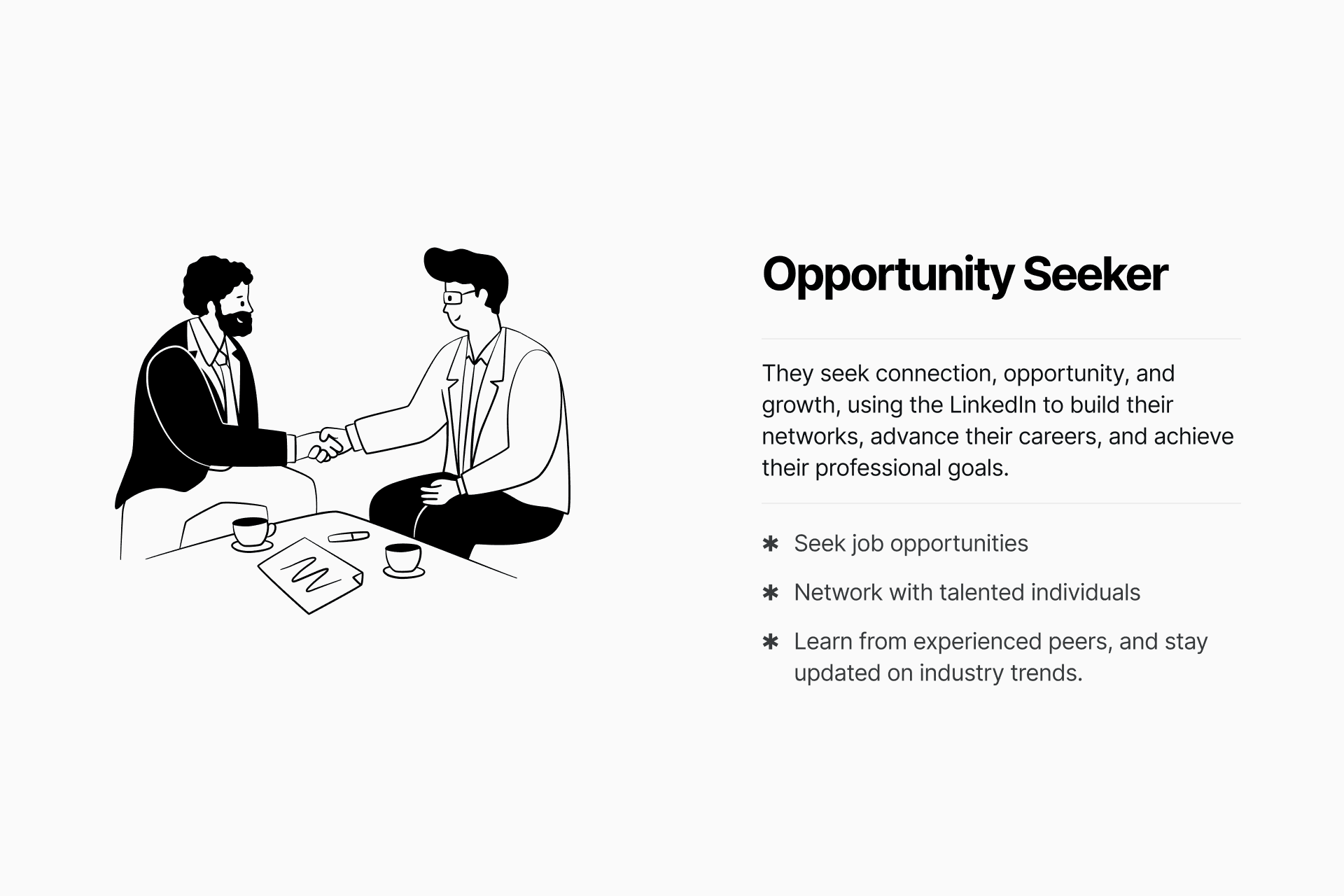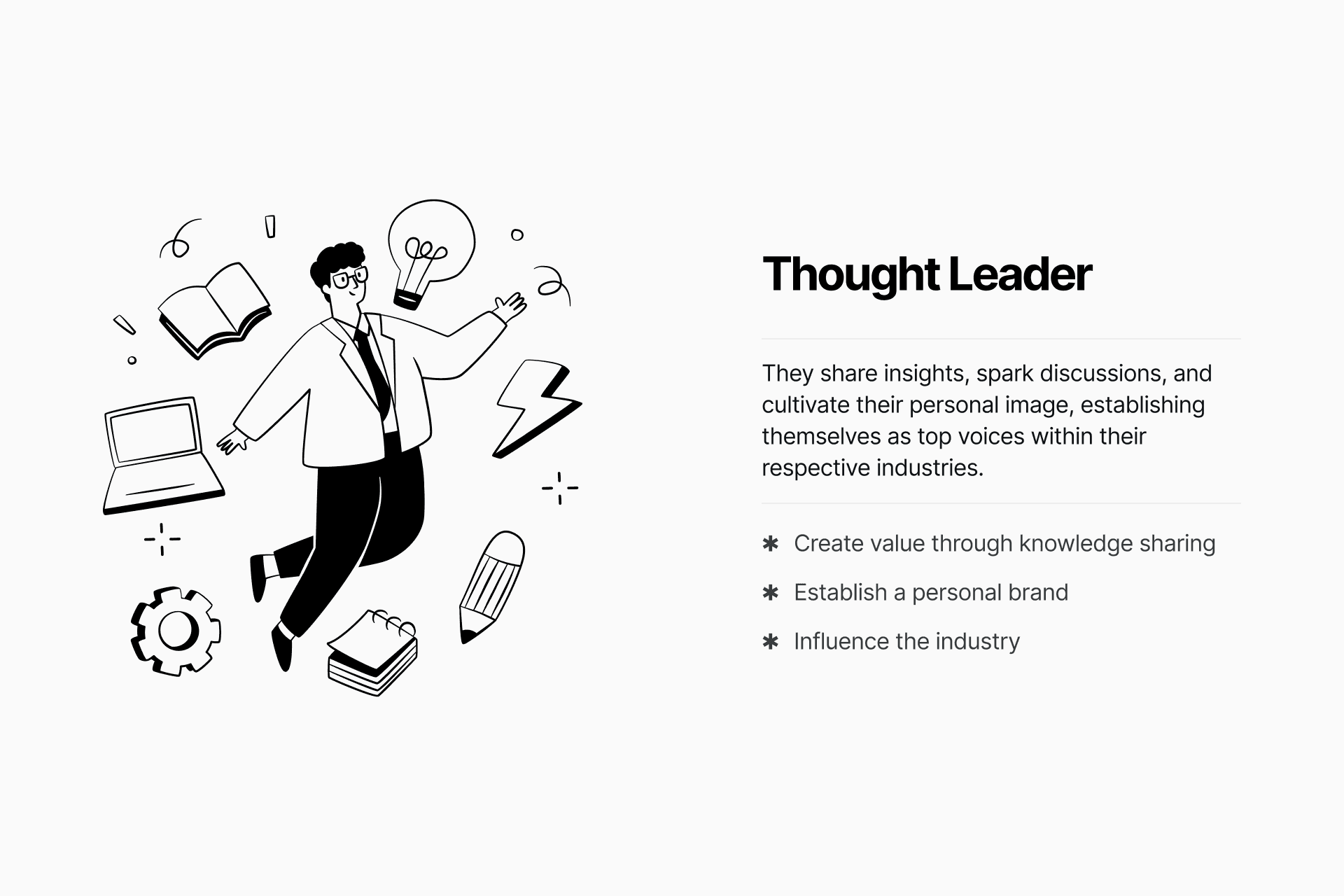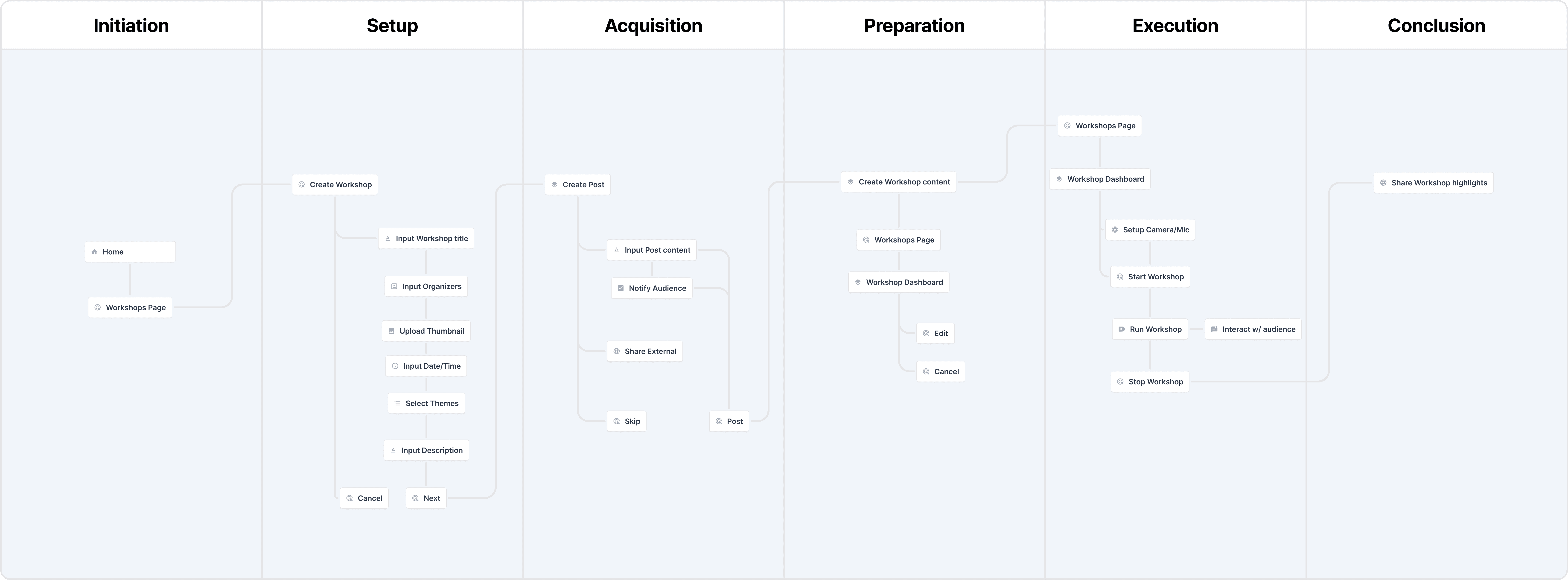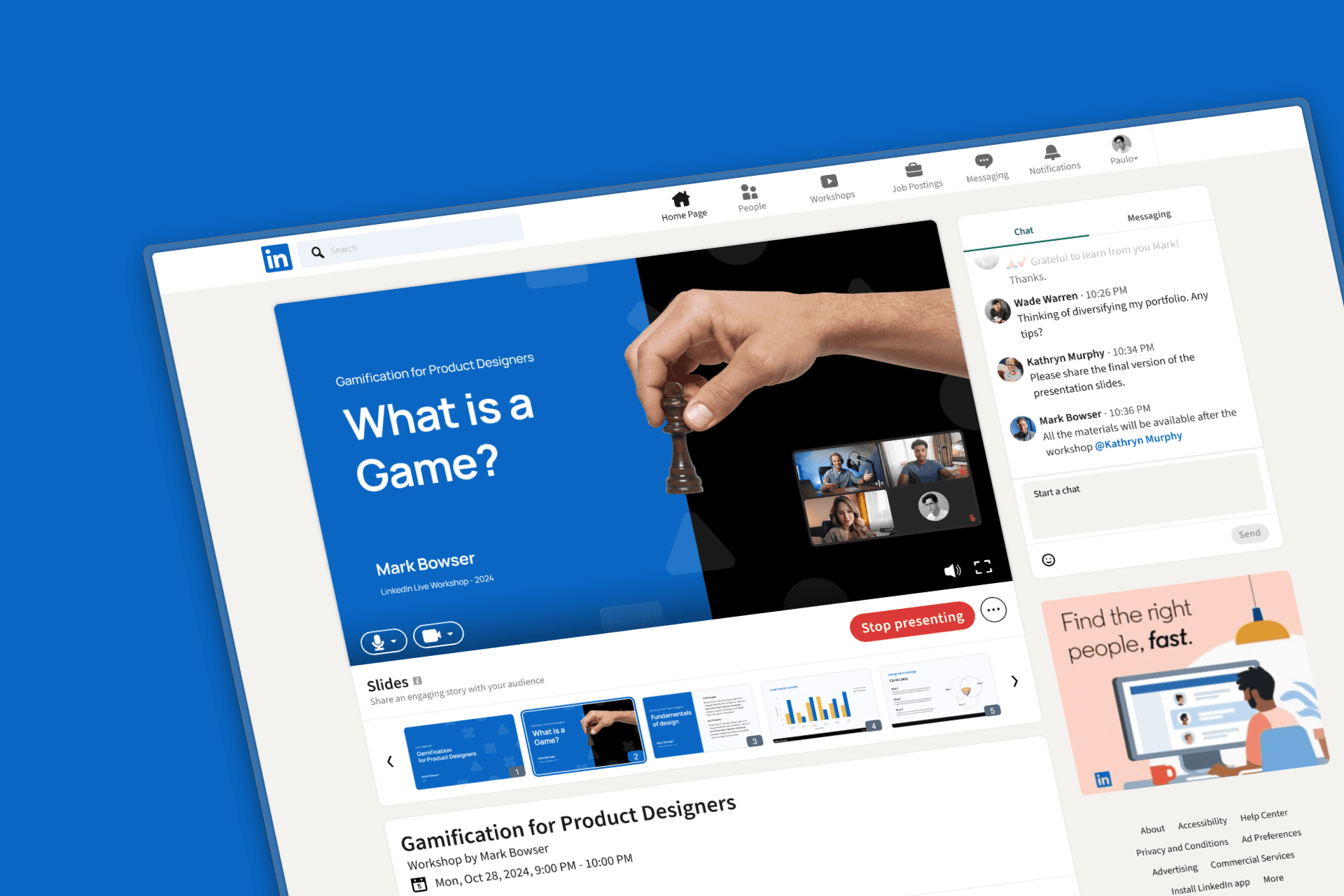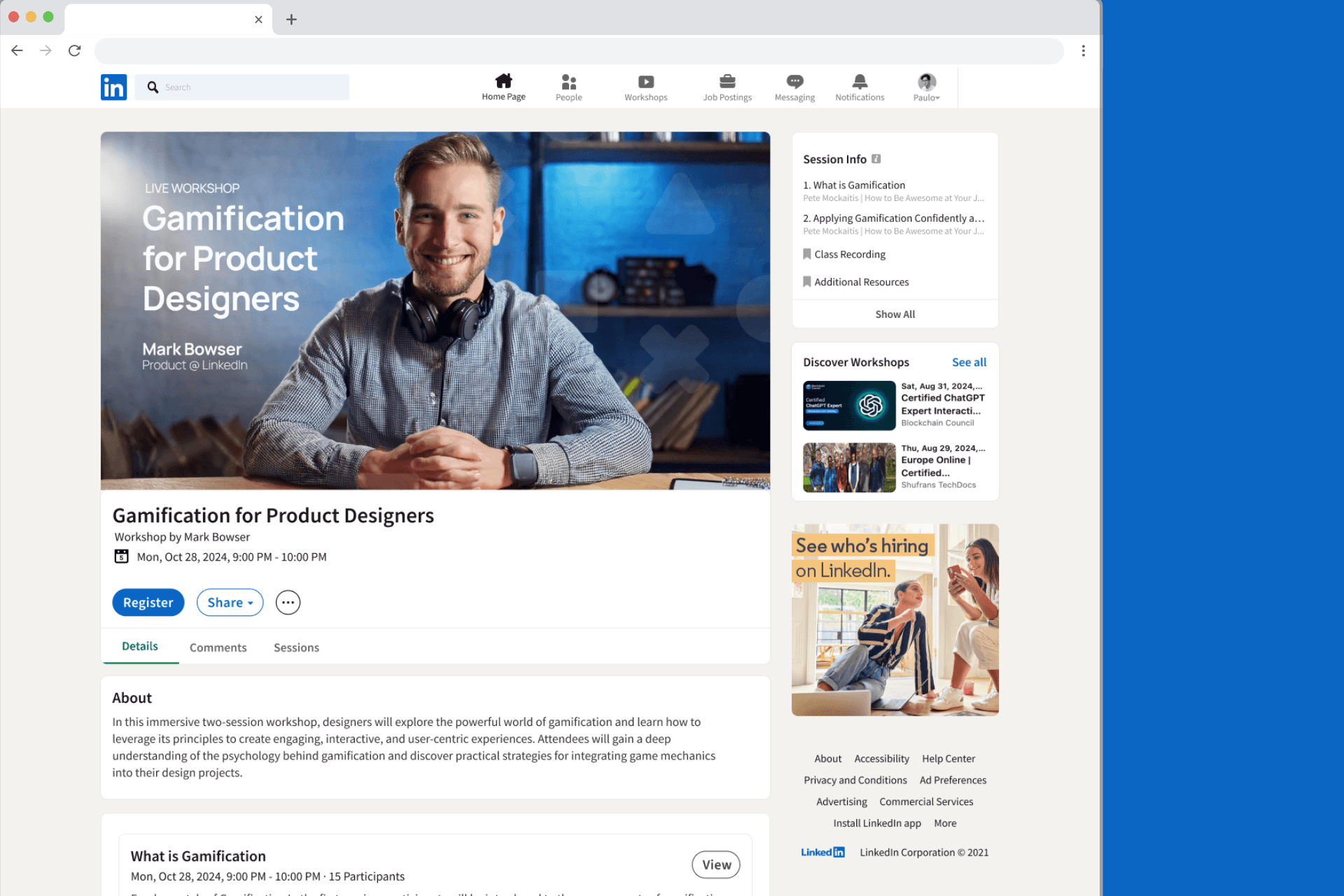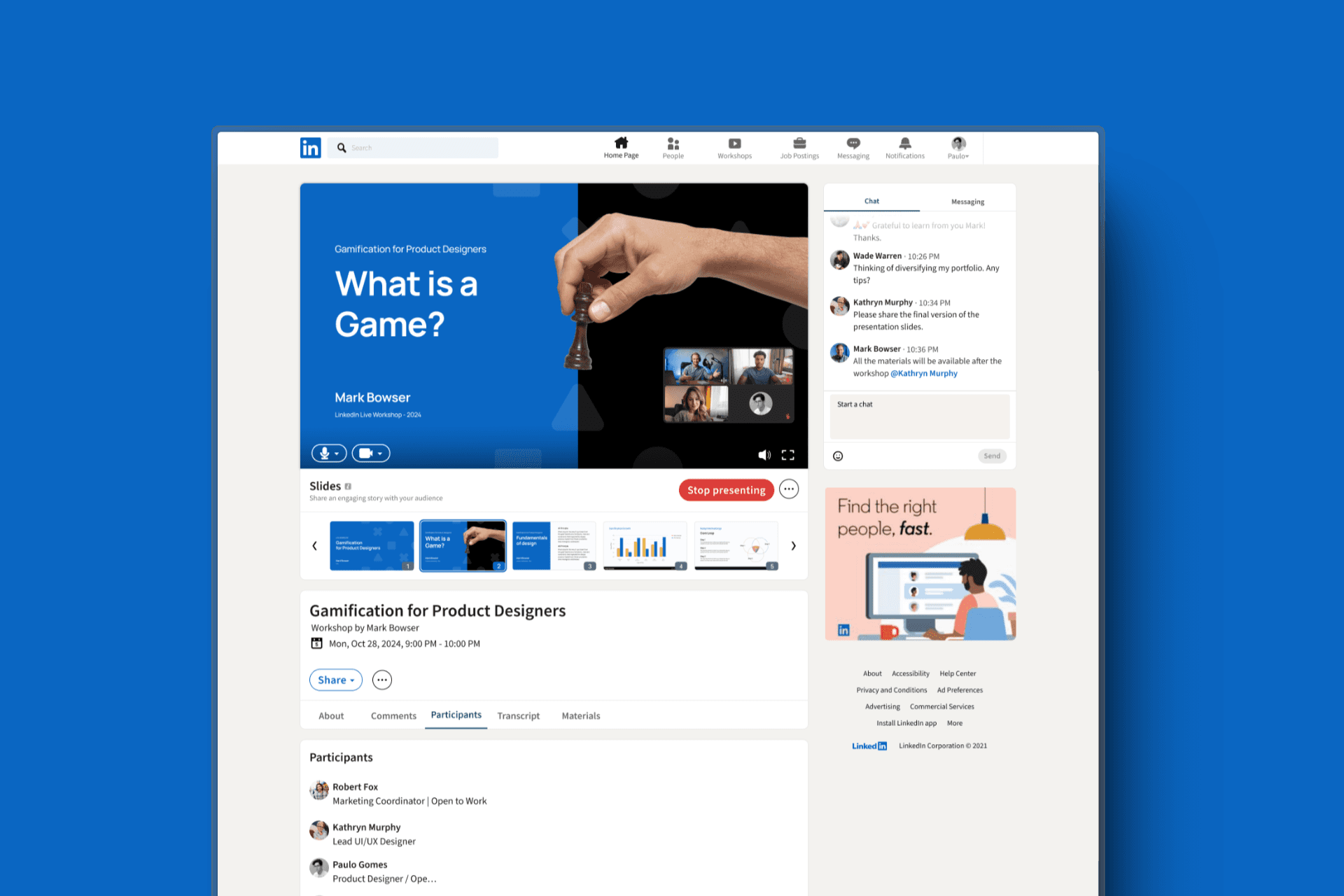Summary
This case study is a self-initiated project aimed at showcasing my product thinking and sharpening my skills by applying knowledge in different scenarios. As a product designer, client confidentiality and nondisclosure agreements (NDAs) constrain most of my professional work and what I can show publicly. This project gave me the chance to openly share how I solve problems and apply design thinking. I set out to create a solution for LinkedIn as the target platform within a weekend.
Due to time constraints, a significant portion of my process was based solely on desk research using data that was readily available to the public and assumptions.
Scope
Research and define audience
Solution hypothesis and strategy
Design concept and next steps
Skills applied
Product Thinking, Secondary Research, Prioritization, UI Design
Challenge
As a leading professional networking platform, LinkedIn has connected millions of individuals worldwide, boasting over 810 million registered members. The platform facilitates numerous job applications every second, demonstrating its value to users. Since Microsoft's acquisition in 2016, LinkedIn has focused on empowering people and organizations by connecting the professional world and creating more intelligent and productive experiences.
However, recent data shows that LinkedIn's growth rate in the US has slowed significantly compared to previous years. This presents an opportunity for the product and design teams to explore new engagement strategies. As a product designer, you're invited to contribute your insights and creativity to this exploration.
Develop ideas
Based on your findings, formulate a hypothesis about how LinkedIn might better serve this user group. Then, create some initial concepts that could potentially address their needs.
Suggest next steps
Propose ways to validate your ideas. This could involve user testing, surveys, or other research methods you find appropriate.
Research
To kickoff the challenge, I started with research through desk research within scope, limmiting myself to:
Examining market research on professional networking trends, industry reports, and LinkedIn's own published data analysis.
Examining competitors or platforms targeting similar user groups.
Investigating online communities, user-generated insights, and data.
The results showed me a range of profiles that make use of LinkedIn, from professionals using the platform to advance their careers, build networks and learn from more experienced peers, to users looking to promote their expertise. Additionally, indicated a trend of users embracing the platform's content creation features, suggesting a shift in user behavior, increasingly seeking to share their expertise and seek opportunities thought authority rather than solely focusing on networking and job searching to prospect new jobs. Consequently, the demand for content both in terms of quantity and quality has increased.
Market Hypothesis
This shift towards content creation provides an opportunity to engage users as they transition from passive networkers to active content consumers. LinkedIn can foster a more engaging and valuable platform for all users by providing key profiles with the tools and support they require to create compelling content.
I categorized profiles with similar motivations into three archetypes and identified experts as the key profile to focus on, assuming that:
Experts share content that other users will consume, thus feeding the system and creating a core loop.
Increased opportunities for monetization of shared content
Alignment with the trends of content creation
We also need to consider there will be people actively feeding from the value created by the Thought Leader archetype; therefore, I set the Opportunity Seeker archetype as a secondary audience to keep in mind while designing.
Ideation
Having identified the key driver for increased engagement, I formulated the following HMW statement: "How might we help [Thought Leaders] create content that delivers value to [Opportunity Seekers]?", this hypothesis steered my brainstorming session, where I explored various solutions.
1
Community-Driven Learning
Empowering Thought Leaders to create and share courses on LinkedIn, diversifying content and boosting platform engagement
2
Paid Content Subscriptions
Enabling Thought Leaders to monetize their content, leveraging scarcity bias to drive engagement and offering exclusive content to paying users.
3
Live Workshops
Integrating live, interactive workshops within LinkedIn, leveraging the existing Events feature and the under-test Live feature to facilitate recurring events.
4
Professional Podcasts
Introducing a dedicated platform for professional podcasts, capitalizing on the format's popularity and aligning with LinkedIn's professional focus.
Prioritization & Selection
To prioritize these ideas, I considered their potential impact and required effort. The live workshops emerged as the most promising solution due to the following factors:
Content Loop: Fosters a continuous cycle of content creation and consumption, with Thought Leaders delivering workshops and Connectors actively engaging in real-time.
Recurring Engagement: Enables regular, scheduled workshops, promoting consistent platform visits and interaction.
Monetization Potential: Offers opportunities for paid workshops, generating revenue for both Thought Leaders and LinkedIn.
Leveraging Existing Features: Builds upon the existing Events and Live features, minimizing development effort and ensuring a smoother integration.
Design Execution
With a clear direction established, I transitioned into the design phase, making use of the 5W1H framework under my toolkit to guide my process:
✦ What
Develop a "Live Workshops" feature seamlessly integrated into the LinkedIn platform.
✦ Why
Align with LinkedIn's mission of empowering individuals through knowledge sharing and connection.
Establish a self-sustaining system that fuels the platform with both content consumption and production.
Create value for both Thought Leaders (monetization, audience building) and Connectors (upskilling, direct access to expertise)
✦ Who
While prioritizing the primary audience due to the challenge's scope, I remained mindful of the secondary audience's needs and their direct interaction with the feature.
✦ When
Thought Leaders will utilize the feature to deliver time-sensitive, interactive content.
✦ Where
Users will primarily access the feature from desktop computers in a dedicated home/studio setup conducive to live presentations and discussions.
✦ How
I then mapped out the user's journey-flow, outlining the necessary steps to conduct a successful workshop. This high-level flow worked as a blueprint for me to think about features.
Whether it is conducted in-person or virtually, a workshop capitalizes on the opportunity for direct communication between the instructor and students. Businesses like Google and Zoom have already created solutions to deal with comparable circumstances, so users are more accustomed to the norms established by these leaders in the field.
I looked for similar solutions and competitor offerings to identify patterns and design conventions, as users tend to prefer interfaces and interactions that align with their existing mental models.
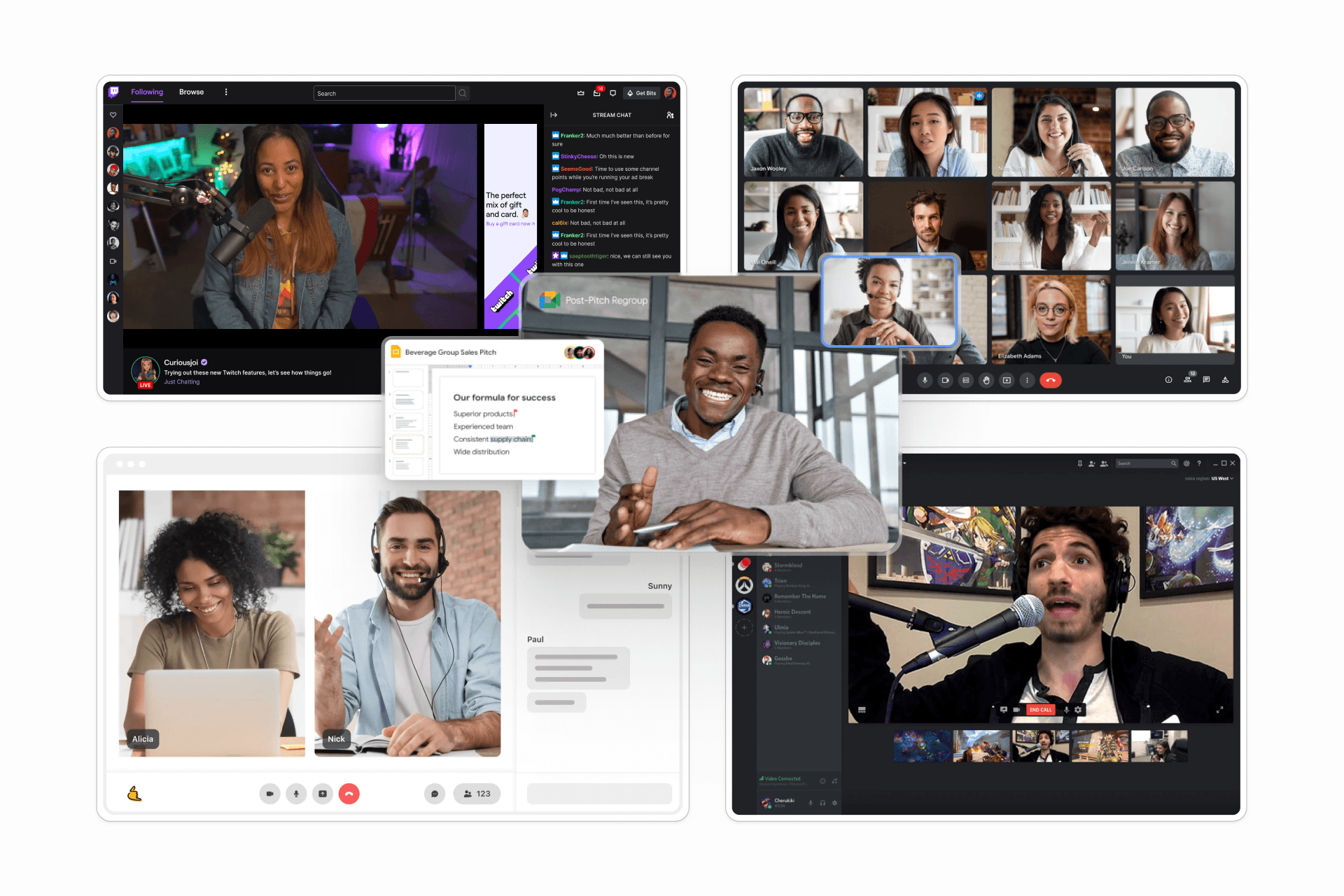
The next step was sketching the interface by incorporating pre-existing patterns and searching for opportunities for differentiation, following Steve Schoger's advice in his book Refactoring UI to "Start with a feature, not a layout." I focused on key screens and chose to go with the following features:
Recurring Dates
Organizers can increase chances of engagement by leveraging habit formation to get their audience to return on recurring workshop dates.
Integration with Microsoft ecosystem
I saw a chance to improve the user experience by incorporating slide shows into LinkedIn itself. By utilizing Microsoft Office integration, this would remove the requirement for other windows or programs when running a workshop.
Direct and Indirect Communication
Participate in group chats and use the second tab for direct messages. This eliminates the need to open additional apps in order to communicate with organizers or facilitators.
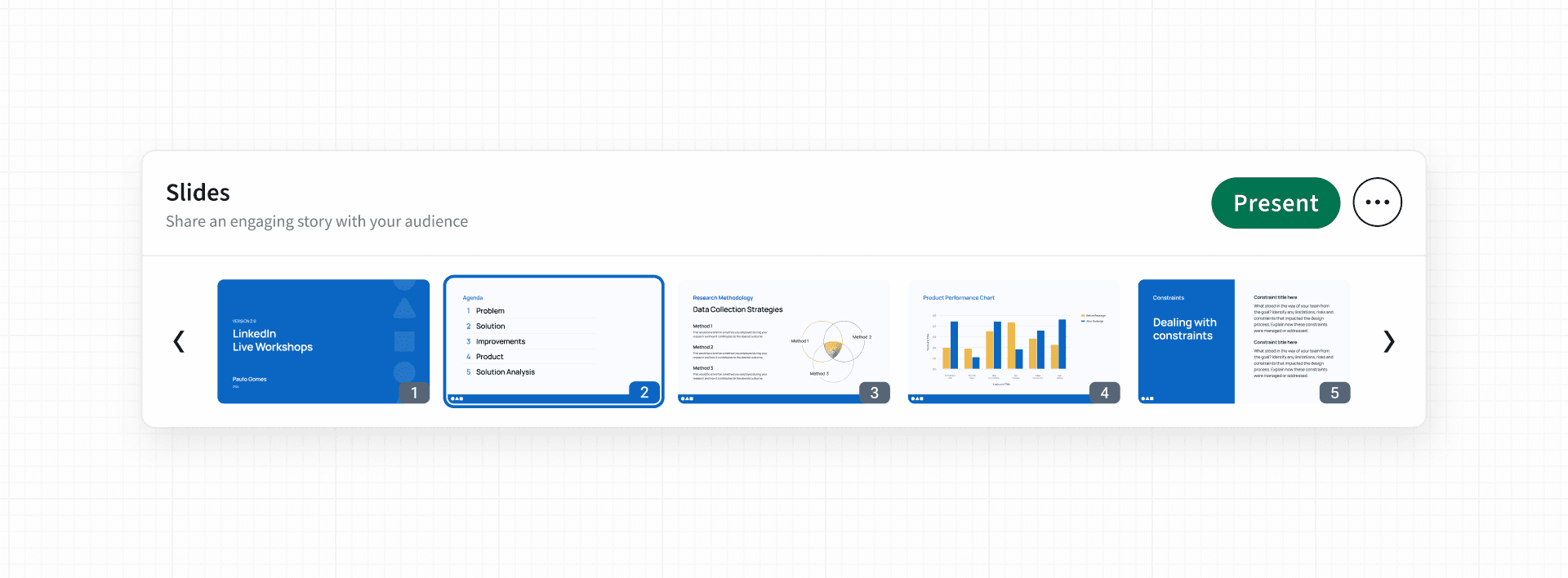
Periodic events create anticipation and increased chances for engagement; I strongly recommend LearningLoop's article on the matter.
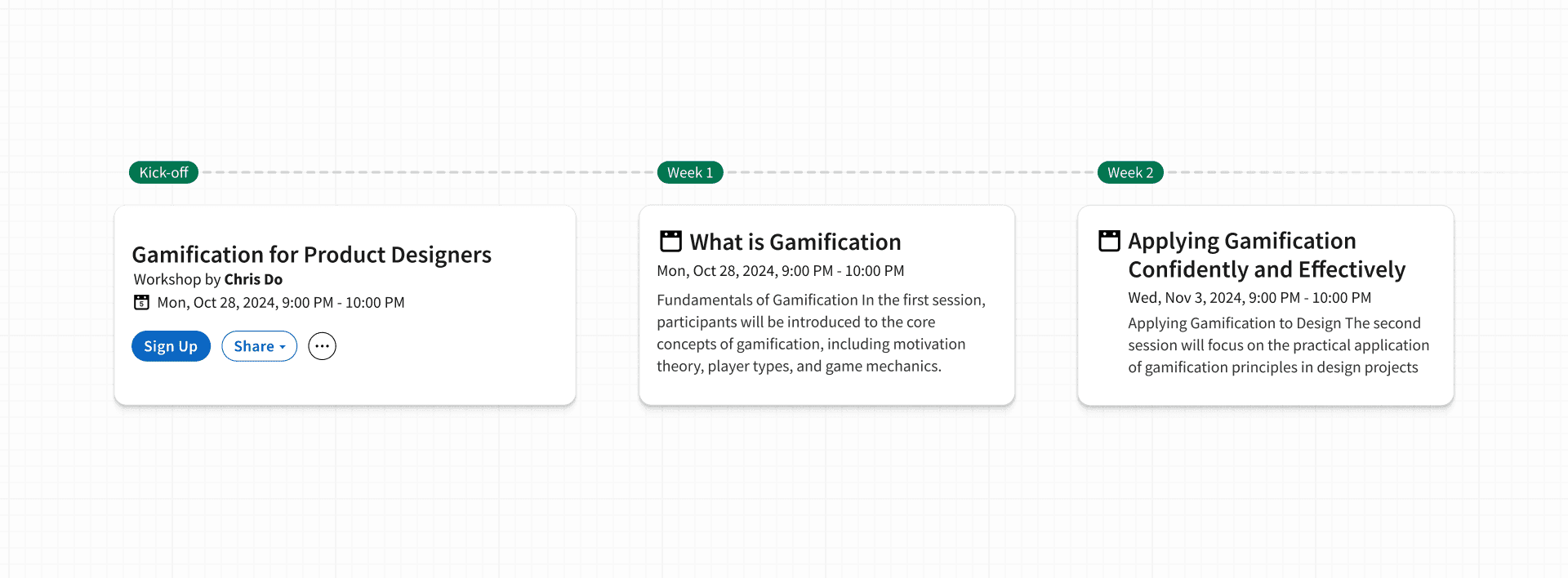
Enabling organizers to present their class slides within LinkedIn, we reduce the chances for user and system errors. Also, reinforcing Microsoft's mission of "creating more intelligent and productive experiences"
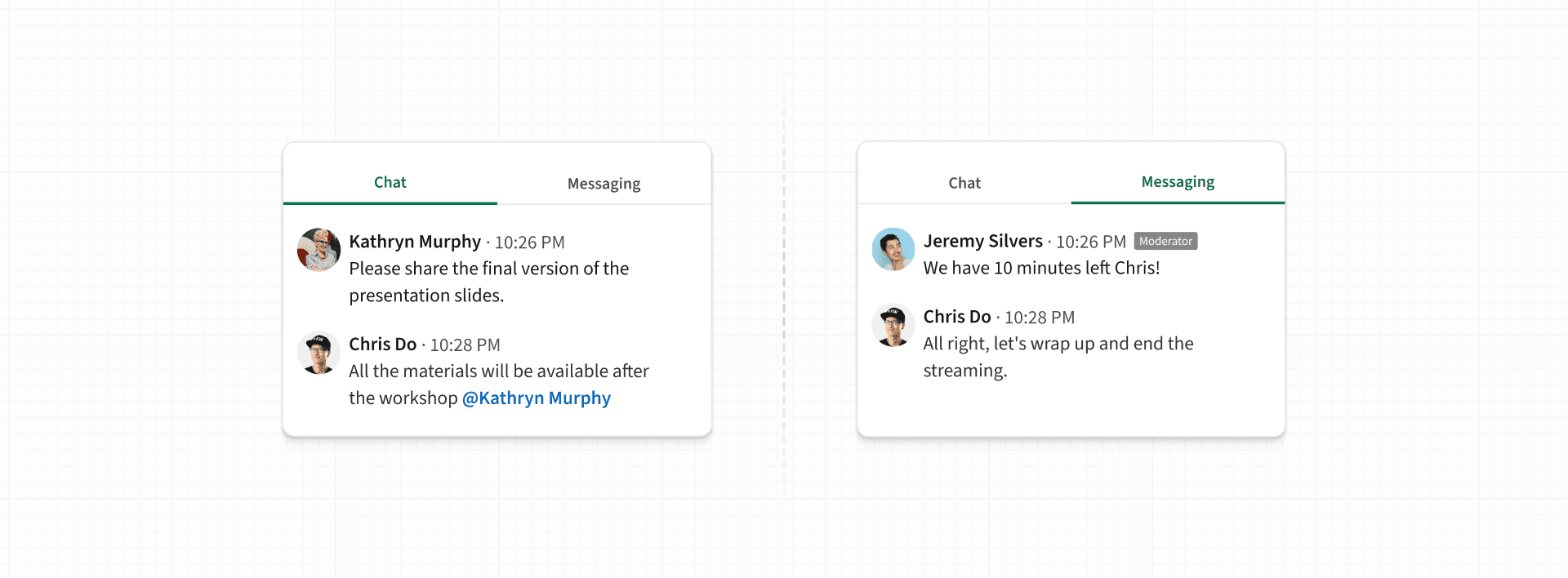
Solutions such as Discord leverage the power of channels to communicate with groups while being able to discuss direct matters with other members.
Putting it all together
Finally, using Figma (my go-to tool), I created simple on-brand components based on LinkedIn's layout to create a concept mockup screen that included the idealized features.
Closing
To bring this concept to life, the following steps would be crucial.
Technical Feasibility: Collaborate with developers and design systems teams to assess the technical feasibility of the proposed solution and determine the optimal integration with LinkedIn's existing infrastructure.
Stakeholder Buy-in: Secure buy-in from key stakeholders by presenting the case study findings, demonstrating the potential impact on user engagement and outlining a clear implementation roadmap.
MVP Development & Limited Beta Launch: Leverage LinkedIn's current tech stack to develop a minimum viable product (MVP) and release it as a limited beta to a select group of Thought Leaders. This exclusivity fosters a sense of value and encourages early adoption.
Data-Driven Validation: Continuously monitor key metrics such as sign-up rates, feature usage, task completion rates, and gather qualitative feedback from beta participants to validate the solution's effectiveness and identify areas for improvement.


